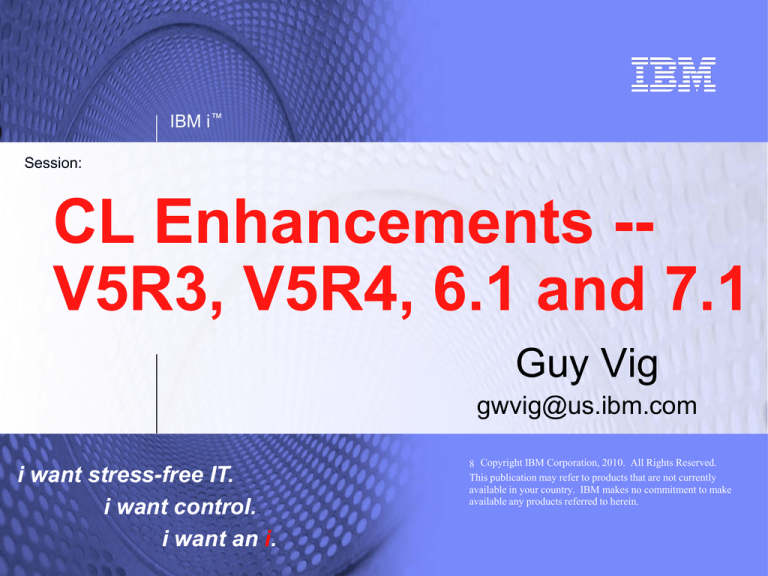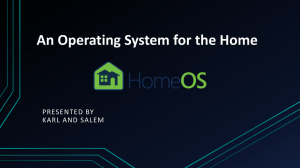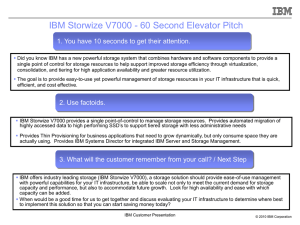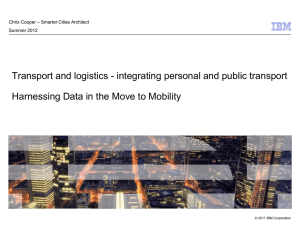
IBM i™
Session:
CL Enhancements -V5R3, V5R4, 6.1 and 7.1
Guy Vig
gwvig@us.ibm.com
i want stress-free IT.
i want control.
i want an i.
8 Copyright IBM Corporation, 2010. All Rights Reserved.
This publication may refer to products that are not currently
available in your country. IBM makes no commitment to make
available any products referred to herein.
IBM i
“General” CL Commands
• There have been new and changed IBM CL
commands in EVERY release
• For V5R3: 57 new, 247 changed commands
• For V5R4: 43 new, 151 changed commands
• For 6.1: 141 new, 319 changed commands
• For 7.1: 38 new, 179 changed commands
3
i want an i.
© 2010 IBM Corporation
IBM i
Binary (Integer) Variables
•New TYPE values of *INT and *UINT
added to the DCL command
** First new CL variable data types since 1980 **
•LEN(2) and LEN(4) supported
•Much "cleaner" than using %BIN built-in
•Passing parameters to APIs
•Passing parameters to other HLL
programs or receiving integer
parameters from other HLL programs
5
i want an i.
© 2010 IBM Corporation
IBM i
Control Flow Enhancements
•Three “flavors” of DO loop commands
–DOWHILE, DOUNTIL, and DOFOR
–Up to 25 levels of DOxxx nesting supported
•Loop control flow commands
–LEAVE and ITERATE
•Case/subcase commands
–SELECT, WHEN, OTHERWISE, and
ENDSELECT
–Up to 25 levels of SELECT nesting supported
7
i want an i.
© 2010 IBM Corporation
IBM i
DOWHILE Loop
• Same COND support as IF statement in CL
• Evaluates COND at "top" of loop
• Old-style coding example:
DCL
VAR(&LGL) TYPE(*LGL)
:
CHECK: IF COND(*NOT &LGL) THEN(GOTO DONE)
:
(group of CL commands)
GOTO CHECK
DONE:
• New-style coding example:
DOWHILE
COND(&LGL)
: (group of CL commands) body will be run zero or more times
ENDDO
9
i want an i.
© 2010 IBM Corporation
IBM i
DOUNTIL Loop
• Similar COND support as IF statement in CL
• Evaluates COND at "bottom" of loop
• Old style coding example:
DCL
VAR(&LGL) TYPE(*LGL)
:
LOOP:
:
(group of CL commands)
IF COND(*NOT &LGL) THEN(GOTO LOOP)
• New style coding example:
DOUNTIL
COND(&LGL)
: (group of CL commands) body will be run one or more times
ENDDO
11
i want an i.
© 2010 IBM Corporation
IBM i
DOFOR Loop
• Syntax:
DOFOR VAR( ) FROM( ) TO( ) BY( )
• BY defaults to '1', other parameters are required
• VAR must be *INT or *UINT variable
• FROM and TO can be integer constants,
expressions, or variables
• BY must be an integer constant (can be negative)
• FROM/TO expressions are evaluated at loop
initiation; TO evaluated after increment
• Checks for loop exit at "top" of loop (like DOWHILE)
13
i want an i.
© 2010 IBM Corporation
IBM i
DOFOR Loop (continued)
• Old-style coding example:
DCL
&LOOPCTL
TYPE(*DEC) LEN(5 0)
DCL &LOOPLMT TYPE(*DEC) LEN(5 0)
:
CHGVAR
&LOOPCTL VALUE(1)
CHECK: IF COND(&LOOPCTL *GT &LOOPLMT)
:
(group of CL commands)
CHGVAR &LOOPCTL VALUE(&LOOPCTL+1)
GOTO CHECK
DONE:
THEN(GOTO
DONE)
• New-style coding example:
DCL &LOOPCTL TYPE(*INT) LEN(4)
DCL &LOOPLMT TYPE(*INT) LEN(4)
:
DOFOR VAR(&LOOPCTL) FROM(1) TO(&LOOPLMT) BY(1)
: (group of CL commands) body will be run zero or more times
ENDDO
15
i want an i.
© 2010 IBM Corporation
IBM i
LEAVE and ITERATE
• Allowed only within a DOWHILE, DOUNTIL or DOFOR group
• LEAVE passes control to next CL statement following loop ENDDO
• ITERATE passes control to end of loop and tests loop exit condition
• Both support CMDLBL (Command label) parameter to allow jump out of
multiple (nested) loops
– Both default to *CURRENT loop
LOOP1: DOFOR &COUNTER FROM(1) TO(&LIMIT)
LOOP2: DOUNTIL COND(&FOUND)
IF (%SST(&NAME 1 10) *EQ ‘*NONE’) THEN(LEAVE LOOP1)
ELSE (DO)
IF (%SST(&NAME 11 10) *EQ ‘*LIBL’) THEN(ITERATE)
ENDDO
ENDDO
/* End of DOUNTIL loop */
ENDDO
/* End of DOFOR loop
*/
17
i want an i.
© 2010 IBM Corporation
IBM i
SELECT Group
• SELECT starts a group; this command has no parameters
• ENDSELECT ends group; this command has no parameters
• Group must have at least one WHEN
– WHEN command has COND and THEN parameters (like IF)
• OTHERWISE (optional) run if no WHEN COND = True
– OTHERWISE command has only CMD parameter (like ELSE)
• Example:
SELECT
WHEN
COND(&TYPE *EQ *CMD) THEN(DO)
:
(group of CL commands)
ENDDO
WHEN
COND(&TYPE *EQ *PGM) THEN(DO)
:
(group of CL commands)
ENDDO
OTHERWISE
CMD(CHGVAR &BADTYPE ‘1’)
ENDSELECT
19
i want an i.
© 2010 IBM Corporation
IBM i
Enhanced File Support
• Will support up to 5 file "instances" using DCLF
– Instances can be different files or the same file
• New OPNID (Open identifier) parameter added to
DCLF statement
– Default for OPNID is *NONE
– Only one DCLF allowed with OPNID(*NONE)
• OPNID accepts simple name, up to 10 characters
21
i want an i.
© 2010 IBM Corporation
IBM i
File Support (continued)
• If OPNID specified, declared CL variables are
prefixed by this name and an underscore (e.g.
&MYTESTFILE_CUSTNAME )
• OPNID added to existing file I/O CL commands
– RCVF
– ENDRCV
– SNDF
– SNDRCVF
– WAIT
23
i want an i.
© 2010 IBM Corporation
IBM i
Longer *CHAR Variables
• Old limit was 9999 bytes for TYPE(*CHAR)
• New limit is 32767 bytes for TYPE(*CHAR)
• DCLF did not generate CL variables for
character fields longer than 9999 bytes in a
record format (this support was added in V5R4)
• Limit for TYPE(*CHAR) and TYPE(*PNAME) on
PARM, ELEM, and QUAL command definition
statements stays at 5000 bytes
• VALUE (on DCL) limited to first 5000 bytes
25
i want an i.
© 2010 IBM Corporation
IBM i
More Parameters
•Previous limit was 40 for PGM and
TFRCTL, and 99 for CALL command
•New limit is 255 parameters for PGM, CALL,
and TFRCTL
•Limit for CALLPRC (only allowed in ILE CL
procedures) stays at 300
•Number of PARM statements in a CL
command increased from 75 to 99
27
i want an i.
© 2010 IBM Corporation
IBM i
Passing Parms "by value" (ILE CL only)
• CALLPRC (Call Procedure) command supports
calls from ILE CL procedures to other ILE
procedures
• In prior releases, CALLPRC only supported
passing parameters "by reference"
• Can specify *BYREF or *BYVAL special value for
each parameter being passed
• Enables ILE CL to call many MI and C functions
and other procedure APIs
• Maximum numbers of parameters still 300
29
i want an i.
© 2010 IBM Corporation
IBM i
CL Documentation
• Guaranteed consistency of online command help
and command documentation in iSeries
Information Center
– Using Java, XML, and XSLT to build HTML in the Info Center from online
help plus command definition object
– Generated HTML has much better navigation than old HTML
– Old syntax diagram replaced with new HTML syntax table
• More complete information in Info Center
– Documentation for ALL products’ CL commands
– Find commands by product in the CL Command Finder
• Examples section added to online CL help
31
i want an i.
© 2010 IBM Corporation
IBM i
Shipped CL Doc Tools
• Provided new GENCMDDOC (Generate
Command Documentation) command in IBM i
– Calls C++ program which invokes Java code shipped with IBM i
• User can generate HTML documentation
– For IBM-supplied commands (will look just like Info Center HTML)
– For user-written commands (that have online help)
• User can generate UIM online help for a *CMD
– Greatly simplifies task of adding help to user-written commands
• Graphical prompters use the Java code too
– Produces HTML that looks like Info Center HTML “on the fly”
– Positions within HTML file to parameter you wanted help for
33
i want an i.
© 2010 IBM Corporation
IBM i
V5R3 Was Not a “One-Shot” Deal
• V5R3 was the biggest release for CL compiler
enhancements since ILE CL compiler in V3R1
– Most new CL compiler function since System/38
• But V5R3 was just the beginning
• More enhancements delivered in V5R4
35
i want an i.
© 2010 IBM Corporation
IBM i
Subroutines
• Simple code block between SUBR and ENDSUBR
commands
• Invoked by new CALLSUBR command
– No argument/parameter passing
– Optional RTNVAL can specify 4-byte *INT variable
– No local scoping of subroutine variables
– Local scoping of labels
– No nesting allowed (subroutines in subroutines)
• Return to caller via RTNSUBR or ENDSUBR
• Cannot use GOTO to enter or leave the body of a
subroutine, OK within a subroutine
37
i want an i.
© 2010 IBM Corporation
IBM i
CL program using a pseudo-subroutine
PGM
DCL &RTNLBL *CHAR 10
:
CHGVAR &RTNLBL 'HERE'
GOTO PSEUDOSUBR /* 1st invocation of pseudo-subroutine */
HERE: /* Return label from 1st invocation of pseudo-subroutine */
:
CHGVAR &RTNLBL 'THERE'
GOTO PSEUDOSUBR /* 2nd invocation of pseudo-subroutine */
THERE: /* Return label from 2nd invocation of pseudo-subroutine */
:
GOTO GO_AROUND
/* Branch around the pseudo-subroutine code
*/
PSEUDOSUBR:
/* Body of pseudo-subroutine PSEUDOSUBR */
:
/* Return-from-subroutine logic */
IF (&RTNLBL *EQ 'HERE') THEN(GOTO HERE)
IF (&RTNLBL *EQ 'THERE') THEN(GOTO THERE)
/* Need to handle any other value for &RTNLBL as an error
*/
GO_AROUND:
:
ENDPGM
39
i want an i.
© 2010 IBM Corporation
IBM i
CL program using a real subroutine
PGM
:
CALLSUBR REALSUBR /* 1st call to the subroutine */
:
CALLSUBR REALSUBR /* 2nd call to the subroutine */
:
/* End of program mainline code */
SUBR REALSUBR
/* Body of subroutine REALSUBR
:
RTNSUBR
:
ENDSUBR
*/
ENDPGM
41
i want an i.
© 2010 IBM Corporation
IBM i
Sample CL with Subroutines
PGM
/* A simple program with two subroutines */
DCLPRCOPT SUBRSTACK(25)
DCL VAR(&SRTNVAR) TYPE(*INT) LEN(4)
DCL VAR(&SDEC) TYPE(*DEC) LEN(5 2)
MONMSG MSGID(CPF0822) EXEC(GOTO CMDLBL(DUMP))
START:
CALLSUBR
DUMP:
DMPCLPGM
SUBR(SUBR1) RTNVAL(&SRTNVAR)
START:
SUBR
SUBR(SUBR1)
CALLSUBR
SUBR(SUBR2)
ENDSUBR
RTNVAL(&SDEC)
START:
SUBR
SUBR(SUBR2)
CALLSUBR
SUBR(SUBR2)
RTNSUBR
RTNVAL(-1)
ENDSUBR
ENDPGM
43
i want an i.
© 2010 IBM Corporation
IBM i
DMPCLPGM Spooled File Output
45
i want an i.
© 2010 IBM Corporation
IBM i
Pointer CL Variables
• Added TYPE(*PTR) on DCL statement
• New %ADDRESS built-in to set pointer
• New %OFFSET built-in to set or retrieve the offset portion
of pointer variable
• Added STG(*BASED) attribute on DCL statement
• Enables calling (or being called by) programs that have
pointer parameters
• Makes many procedure APIs available to ILE CL
– Full record-level file I/O
– String functions
47
i want an i.
© 2010 IBM Corporation
IBM i
Defined-on CL Variables
• Added STG(*DEFINED) keyword on DCL command
• Must give name of defined-over CL variable (new
DEFVAR keyword on DCL command)
• Can optionally provide starting position (default = 1) from
beginning of the defined-over CL variable
• Useful for varying-character fields and providing CL
mapping of structures
49
i want an i.
© 2010 IBM Corporation
IBM i
Examples of V5R4 DCL Enhancements
• Declaring *DEFINED CL Variables
DCL &QUALOBJ *CHAR LEN(20)
DCL &OBJ *CHAR LEN(10) STG(*DEFINED) DEFVAR(&QUALOBJ 1)
DCL &LIB *CHAR LEN(10) STG(*DEFINED) DEFVAR(&QUALOBJ 11)
• Declaring a Pointer CL Variable
DCL
&CHARVAR
DCL
&PTRVAR
*CHAR
*PTR
LEN(10)
ADDRESS(&CHARVAR)
• Declaring a *BASED CL Variable
DCL
DCL
&ENTRYPTR *PTR
&CHARENTRY *CHAR 10
STG(*BASED) BASPTR(&ENTRYPTR)
• Declaring a *DEFINED Pointer CL Variable
DCL
DCL
51
&CHARSTRUCT *CHAR LEN(48)
&PTRVAR2 *PTR STG(*DEFINED) DEFVAR(&CHARSTRUCT 17)
i want an i.
© 2010 IBM Corporation
IBM i
Example CL of DCL Enhancements
PGM
DCL &QUALOBJ *CHAR LEN(20)
DCL &OBJ *CHAR LEN(10) STG(*DEFINED) DEFVAR(&QUALOBJ 1)
DCL &LIB *CHAR LEN(10) STG(*DEFINED) DEFVAR(&QUALOBJ 11)
DCL &CHARVAR *CHAR LEN(10)
DCL &PTRVAR *PTR ADDRESS(&CHARVAR)
DCL &ENTRYPTR *PTR
DCL &CHARENTRY *CHAR 10 STG(*BASED) BASPTR(&ENTRYPTR)
DCL &CHARSTRUCT *CHAR LEN(32) VALUE(‘FIRSTENTRY’)
DCL &PTRVAR2 *PTR STG(*DEFINED) DEFVAR(&CHARSTRUCT 17)
/* Set
CHGVAR
CHGVAR
CHGVAR
CHGVAR
CHGVAR
values into the CL variables */
&OBJ 'MYMSGF'
&LIB 'MYLIB'
&CHARVAR 'ABCDEFGHIJ'
&PTRVAR2 (%ADDRESS(&CHARSTRUCT))
&ENTRYPTR &PTRVAR2
/* Dump the program to show values of CL variables */
DMPCLPGM
ENDPGM
53
i want an i.
© 2010 IBM Corporation
IBM i
Compiler Cross-Reference Listing
55
i want an i.
© 2010 IBM Corporation
IBM i
DMPCLPGM Spooled File Output
57
i want an i.
© 2010 IBM Corporation
IBM i
Using Based & Defined Variables
• Accessing API output data using %SUBSTRING
DCL &LISTHDR *CHAR 192
IF COND(%SST(&LISTHDR 104 1) = 'C') THEN(DO)
• Accessing API output data using *DEFINED variable
DCL &LISTHDR *CHAR 192
DCL &LISTSTS *CHAR 1 STG(*DEFINED) DEFVAR(&LISTHDR 104)
IF COND(&LISTSTS = 'C') THEN(DO)
• Accessing API output directly using pointer to user space
DCL &USRSPCPTR *PTR
DCL &LISTHDR *CHAR 192 STG(*BASED) BASPTR(&USRSPCPTR)
DCL &LISTSTS *CHAR 1 STG(*DEFINED) DEFVAR(&LISTHDR 104)
IF COND(&LISTSTS = 'C') THEN(DO)
59
i want an i.
© 2010 IBM Corporation
IBM i
Example CL Using Pointer Variable
PGM
PARM(&SCANVALUE
&NEWVALUE)
/* Replace all occurrences of parameter &SCANVALUE
/* in &STRING with parameter &NEWVALUE
DCL VAR(&SCANVALUE) TYPE(*CHAR) LEN(1)
DCL VAR(&NEWVALUE) TYPE(*CHAR) LEN(1)
DCL VAR(&STRING) TYPE(*CHAR) LEN(26) +
VALUE('This is the string to scan')
DCL
DCL
*/
*/
VAR(&BASEPTR) TYPE(*PTR) ADDRESS(&STRING)
VAR(&SCANFOUND) TYPE(*CHAR) LEN(1) +
STG(*BASED) BASPTR(&BASEPTR)
DCL
VAR(&CONTROLS) TYPE(*CHAR) LEN(8) +
VALUE(X'010000000000001A') +
/* Start scan with a string length of 26 bytes */
DCL
&RTNCDE TYPE(*INT) LEN(4)
61
i want an i.
© 2010 IBM Corporation
IBM i
Example CL Using Pointer Variable (continued)
CHGVAR VAR(%SST(&CONTROLS 4 1)) VALUE(&SCANVALUE)
CALLPRC
PRC('_SCANX') PARM((&BASEPTR) +
(&CONTROLS) (X'48000000' *BYVAL)) +
RTNVAL(&RTNCDE) /* Scan the string */
/* Loop to find all occurrences of &SCANVALUE
*/
DOWHILE
COND(&RTNCDE=0) /* Scan value found? */
CHGVAR
VAR(&SCANFOUND) VALUE(&NEWVALUE)
CALLPRC
PRC('_SCANX') PARM((&BASEPTR) +
(&CONTROLS) (X'48000000' *BYVAL)) +
RTNVAL(&RTNCDE) /* Scan string again */
ENDDO
/* Output the resulting string in a message
SNDPGMMSG MSG(&STRING) TOPGMQ(*EXT)
ENDPGM
63
i want an i.
*/
© 2010 IBM Corporation
IBM i
Debug using Existing Tools
65
i want an i.
© 2010 IBM Corporation
IBM i
Using *BASED and *DEFINED with List API
/* Generic header information
*/
DCL
VAR(&USRSPCPTR) TYPE(*PTR)
DCL
VAR(&LISTHDR) TYPE(*CHAR) STG(*BASED) +
LEN(192) BASPTR(&USRSPCPTR)
DCL
VAR(&LISTSTS) TYPE(*CHAR) STG(*DEFINED) +
LEN(1) DEFVAR(&LISTHDR 104)
DCL
VAR(&LISTENTOFS) TYPE(*INT) STG(*DEFINED) +
DEFVAR(&LISTHDR 125)
DCL
VAR(&LISTENTNBR) TYPE(*INT) STG(*DEFINED) +
DEFVAR(&LISTHDR 133)
DCL
VAR(&LISTENTSIZ) TYPE(*INT) STG(*DEFINED) +
DEFVAR(&LISTHDR 137)
/* List object detail information
DCL
VAR(&LISTENTPTR) TYPE(*PTR)
DCL
VAR(&LISTENT) TYPE(*CHAR) STG(*BASED) +
LEN(30) BASPTR(&LISTENTPTR)
DCL
VAR(&OBJNAME) TYPE(*CHAR) STG(*DEFINED) +
LEN(10) DEFVAR(&LISTENT 1)
DCL
VAR(&OBJTYPE) TYPE(*CHAR) STG(*DEFINED) +
LEN(10) DEFVAR(&LISTENT 21)
67
i want an i.
*/
© 2010 IBM Corporation
IBM i
Using *BASED and *DEFINED (continued)
/* Miscellaneous variables
DCL
VAR(&CURRENT) TYPE(*INT)
DCL
VAR(&TEXT) TYPE(*CHAR) LEN(50)
*/
/* Test to see if user space exists
*/
CHKOBJ
OBJ(QTEMP/OBJLIST) OBJTYPE(*USRSPC) MBR(*NONE)
/* Create user space if not found
*/
MONMSG
MSGID(CPF9801) EXEC(CALL PGM(QUSCRTUS) +
PARM('OBJLIST
QTEMP
' 'QUSLOBJ
' +
X'00000001' X'00' '*CHANGE
' 'Output from +
QUSLOBJ API'))
68
/* Get list of all objects in the QTEMP library
CALL
PGM(QUSLOBJ) PARM('OBJLIST
QTEMP
' +
'OBJL0100' '*ALL
QTEMP
' '*ALL')
*/
/* Get pointer to user space
CALL
PGM(QUSPTRUS) PARM('OBJLIST
&USRSPCPTR)
*/
i want an i.
QTEMP
' +
© 2010 IBM Corporation
IBM i
Using *BASED and *DEFINED (continued)
/* Was the list built successfully?
*/
IF COND((&LISTSTS = 'C') *AND (&LISTENTNBR > 0)) +
THEN(DO)
/* Address the first list entry
*/
CHGVAR
VAR(&LISTENTPTR) VALUE(&USRSPCPTR)
CHGVAR
VAR(%OFFSET(&LISTENTPTR)) +
VALUE(%OFFSET(&LISTENTPTR) + &LISTENTOFS)
/* Process all returned entries
*/
DOFOR
VAR(&CURRENT) FROM(1) TO(&LISTENTNBR)
/* Write the object information
*/
CHGVAR
VAR(&TEXT) VALUE('Object: ' +
*CAT &OBJNAME +
*CAT ' Type: ' *CAT &OBJTYPE)
SNDPGMMSG MSG(&TEXT) TOPGMQ(*EXT)
/* Address the next list entry
*/
CHGVAR
VAR(%OFFSET(&LISTENTPTR)) +
VALUE(%OFFSET(&LISTENTPTR) + &LISTENTSIZ)
ENDDO
SNDPGMMSG
ENDDO
69
MSG('End of list') TOPGMQ(*EXT)
i want an i.
© 2010 IBM Corporation
IBM i
More File I/O in CL
DDS for record format for database file FILEA
R RECORD
KEYVALUE
DATA
MOREDATA
K KEYVALUE
5
10
10
0
CL that defines the same record format for FILEA
DCL
DCL
DCL
DCL
DCL
DCL
71
&RECORD *CHAR LEN(23)
/* Record buffer
*/
&RECORDSIZE TYPE(*INT) VALUE(23) /* Record length
*/
&KEY *DEC LEN(5 0) STG(*DEFINED) DEFVAR(&RECORD)
&KEYSIZE TYPE(*INT) VALUE(3)
/* Size of key (bytes) */
&DATA *CHAR LEN(10) STG(*DEFINED) DEFVAR(&RECORD 4)
&MOREDATA *CHAR LEN(10) STG(*DEFINED) DEFVAR(&RECORD 14)
i want an i.
© 2010 IBM Corporation
IBM i
CL for opening database file FILEA
DCL
DCL
DCL
DCL
&NULL TYPE(*CHAR) LEN(1) VALUE(X'00')
&FILENAME *CHAR 11
/* File to be worked with */
&MODE *CHAR 50
/* Open modes
*/
&RFILE *PTR
/* File pointer
*/
/* File feedback information
DCL &FEEDBACK TYPE(*PTR)
/* I/O feedback pointer
DCL &FDBCKDATA TYPE(*CHAR) STG(*BASED) +
LEN(64) BASPTR(&FEEDBACK) /* Feedback data
DCL &NUM_BYTES TYPE(*INT) STG(*DEFINED) +
DEFVAR(&FDBCKDATA 37) /* Number of bytes processed
*/
*/
*/
*/
/* Open FILEA by calling _Ropen which returns file pointer */
CHGVAR VAR(&FILENAME) VALUE('FILEA' *TCAT &NULL)
CHGVAR VAR(&MODE) VALUE('rr+' *TCAT &NULL)
CALLPRC PRC('_Ropen') PARM((&FILENAME) (&MODE)) +
RTNVAL(&RFILE)
73
i want an i.
© 2010 IBM Corporation
IBM i
CL for reading a record by key
PGM
PARM(&KEYIN &DATAIN)
:
DCL &KEYIN *DEC LEN(15 5) /* Key of record for update
DCL &DATAIN *CHAR LEN(10) /* Value to update record with
DCL &KEY *DEC LEN(5 0) STG(*DEFINED) DEFVAR(&RECORD)
DCL &OPTS TYPE(*INT)
/* Options for _Rreadk
DCL &KEY_EQ TYPE(*INT) VALUE(X’0B000100’) /* Equal to Key
DCL &RTNCDE TYPE(*INT)
/* Return code
:
CHGVAR VAR(&KEY) VALUE(&KEYIN)
CHGVAR VAR(&OPTS) VALUE(&KEY_EQ)
*/
*/
*/
*/
*/
/* Call _Rreadk to try to read record with key field = &KEYIN */
CALLPRC PRC('_Rreadk') +
PARM((&RFILE *BYVAL) (&RECORD) (&RECORDSIZE *BYVAL) +
(&OPTS *BYVAL) (&KEY) (&KEYSIZE *BYVAL)) +
RTNVAL(&FEEDBACK)
75
i want an i.
© 2010 IBM Corporation
IBM i
CL for adding or updating a record
/* If no record has matching key, write a new record
*/
IF COND(&NUM_BYTES *EQ 0) THEN(DO)
CHGVAR VAR(&DATA) VALUE(&DATAIN)
CHGVAR VAR(&MOREDATA) VALUE('
')
CALLPRC PRC('_Rwrite') +
PARM((&RFILE *BYVAL) (&RECORD) (&RECORDSIZE *BYVAL)) +
RTNVAL(&FEEDBACK)
ENDDO
/* Record was read successfully, update the existing record */
ELSE (DO)
CHGVAR VAR(&DATA) VALUE(&DATAIN)
CALLPRC PRC('_Rupdate') +
PARM((&RFILE *BYVAL) (&RECORD) (&RECORDSIZE *BYVAL)) +
RTNVAL(&FEEDBACK)
ENDDO
77
i want an i.
© 2010 IBM Corporation
IBM i
Reading the Contents of a Directory
(by Scott Klement)
PGM
DCL
DCL
DCL
DCL
DCL
DCL
DCL
DCL
DCL
VAR(&NUL)
VAR(&DIRNAME)
VAR(&EXT)
VAR(&POS)
VAR(&SUCCESS)
VAR(&HANDLE)
VAR(&ENTRY)
VAR(&NULLPTR)
VAR(&STMF)
TYPE(*CHAR)
TYPE(*CHAR)
TYPE(*CHAR)
TYPE(*INT)
TYPE(*INT)
TYPE(*PTR)
TYPE(*PTR)
TYPE(*PTR)
TYPE(*CHAR)
LEN(1)
VALUE(X'00')
LEN(200)
LEN(4)
LEN(4)
LEN(4)
LEN(640)
/***********************************************************/
/* Directory entry returned from readdir. It's 796 chars */
/* long with a field called &NAMELEN in positions 53-56
*/
/* and a field called &NAME in positions 57-696
*/
/***********************************************************/
DCL VAR(&DIRENT) TYPE(*CHAR) LEN(796) +
DCL VAR(&NAMELEN) STG(*DEFINED) DEFVAR(&DIRENT 53) +
TYPE(*UINT) LEN(4)
DCL VAR(&NAME)
STG(*DEFINED) DEFVAR(&DIRENT 57) +
TYPE(*CHAR) LEN(640)
79
i want an i.
© 2010 IBM Corporation
IBM i
Reading the Contents of a Directory (continued)
/**********************************************/
/* Open the /edi/incoming/custdata directory: */
/* the API returns a NULL pointer to indicate */
/* failure.
*/
/**********************************************/
CHGVAR VAR(&DIRNAME) VALUE('/edi/incoming/tabdata' *CAT &NUL)
CALLPRC PRC('opendir') PARM((&DIRNAME)) RTNVAL(&HANDLE)
IF (&HANDLE *EQ &NULLPTR) DO
SNDPGMMSG MSGID(CPF9897) MSGF(QCPFMSG) MSGDTA('Unable +
to open directory!') MSGTYPE(*ESCAPE)
ENDDO
/**********************************************/
/* Read the contents of the directory
*/
/**********************************************/
CALLPRC PRC('readdir') PARM((&HANDLE *BYVAL)) RTNVAL(&ENTRY)
81
i want an i.
© 2010 IBM Corporation
IBM i
Reading the Contents of a Directory (continued)
/* Copy each stream file that ends with .TAB to PF TRANMAST */
DOWHILE COND(&ENTRY *NE &NULLPTR)
CHGVAR VAR(&STMF) VALUE(%SST(&NAME 1 &NAMELEN))
/* extract the last 4 characters from the filename */
IF (&NAMELEN *GE 4) DO
CHGVAR VAR(&POS) VALUE(&NAMELEN - 3)
CHGVAR VAR(&EXT) VALUE(%SST(&STMF &POS 4))
ENDDO
ELSE +
CHGVAR VAR(&EXT) VALUE('
')
/* if stream file extender is '.TAB‘, copy to physical file + and
delete stream file (so it doesn't get processed again) */
IF ((&EXT *EQ '.TAB') *OR (&EXT *EQ '.tab')) DO
CPYFRMIMPF FROMSTMF(&STMF) TOFILE(TRANMAST) MBROPT(*ADD) +
RCDDLM(*CRLF) FLDDLM(*TAB) RPLNULLVAL(*FLDDFT)
DEL OBJLNK(&STMF)
ENDDO
CALLPRC PRC('readdir') PARM((&HANDLE *BYVAL)) RTNVAL(&ENTRY)
ENDDO
83
i want an i.
© 2010 IBM Corporation
IBM i
Reading the Contents of a Directory (continued)
/**********************************************/
/* Close the directory
*/
/**********************************************/
CALLPRC PRC('closedir') PARM((&HANDLE *BYVAL)) +
RTNVAL(&SUCCESS)
/**********************************************/
/* Call an RPG program to process the new
*/
/* transactions in the physical file
*/
/**********************************************/
CALL PGM(PROCESS)
ENDPGM
85
i want an i.
© 2010 IBM Corporation
IBM i
Dynamic Storage using ILE C Library Functions
/********************************************************/
/* Do CRTCLMOD followed by CRTPGM with BNDDIR(QC2LE)
*/
/********************************************************/
DCL &RCVVARPTR TYPE(*PTR)
DCL &RCVVARSIZ TYPE(*INT) VALUE(256)
DCL &RCVVAR *CHAR 256 STG(*BASED) BASPTR(&RCVVARPTR)
DCL &BYTRTN *INT 4 STG(*DEFINED) DEFVAR(&RCVVAR)
DCL &BYTAVL *INT 4 STG(*DEFINED) DEFVAR(&RCVVAR 5)
DCL &CRTDATE *CHAR 13 STG(*DEFINED) DEFVAR(&RCVVAR 65)
87
CALLPRC
PRC('malloc') PARM((&RCVVARSIZ *BYVAL)) +
RTNVAL(&RCVVARPTR)
CALL
PGM(QUSROBJD) PARM(&RCVVAR &RCVVARSIZ +
'OBJD0100' 'QGPL
QSYS
'*LIB
')
SNDUSRMSG
MSG(&CRTDATE) MSGTYPE(*INFO) TOMSGQ(*EXT)
CALLPRC
PRC('free') PARM((&RCVVARPTR *BYVAL))
i want an i.
' +
© 2010 IBM Corporation
IBM i
Summary (so far)
• Enhancements in V5R3 made CL a better application
development language and let you do more in your CL
programs
• Further CL compiler enhancements in V5R4 really
opened up what a CL can do
• You’ve seen just a few examples that demonstrate some
of the ways the CL compiler enhancements can extend
what you can do in a CL program or ILE CL procedure
89
i want an i.
© 2010 IBM Corporation
IBM i
V6R1 -- CL Compiler
• New CLOSE command
– Ability to read a database file multiple times
– Next RCVF after a CLOSE implicitly reopens the file
– Can use with OVRDBF to read multiple file members or
reposition to a different record before next open
• New INCLUDE command
– Ability to imbed additional CL source at compile time
– Similar to /COPY in RPG or #include in C/C++
– INCFILE parameter added to CRTCLxxx commands
– New option (RTVINCSRC) added to RTVCLSRC
91
i want an i.
© 2010 IBM Corporation
IBM i
V6R1 -- CL Compiler (continued)
• Support creation options in CL source code
– Added many CRTCLxxx parameters to DCLPRCOPT
– Also BNDSRVPGM & BNDDIR parameters
– Similar to some types of H-specs in RPG
• Support for *NULL special value
– Can specify for ADDRESS value on DCL for TYPE(*PTR)
– Can assign to *PTR variable on CHGVAR command
– Can specify in pointer expressions (e.g. on IF or WHEN)
• API to check for valid object name (QCAVFYNM)
93
i want an i.
© 2010 IBM Corporation
IBM i
V6R1 -- CL Commands
• Option added for dynamic prompt text
– All new or refreshed IBM products will use this option
– No longer ship commands in QSYS29nn NLV libraries
– Simplifies command authorization (one in product lib)
– Enables IBM to PTF commands more like programs
• Support creation options in command source code
– Added many CRTCMD parameters to CMD command
• Support for Unicode CL command strings/parameters
– Mostly needed for Integrated File System directories and files
95
i want an i.
© 2010 IBM Corporation
IBM i
V7R1 -- CL Compiler
• Support for 8-byte integer CL variables (ILE CL only)
– Allow LEN(8) for TYPE(*INT) or TYPE(*UINT) on DCL command
– Passing parameters between CL and other HLL programs
• For example, ILE RPG and C/C++ support 8-byte integer variables
– Handle 8-byte integers returned by IBM i APIs
• For example, disk I/O and CPU amounts returned by QUSRJOBI API
• Support encrypted debug view (ILE CL only)
– New DBGENCKEY parameter on CRTCLMOD and CRTBNDCL
– Assuming DBGVIEW(*LIST) specified, it will be encrypted
– Need to specify same key value on STRDBG or GUI to decrypt
• After three failed attempts, you can still debug, but without the listing view
97
i want an i.
© 2010 IBM Corporation
IBM i
V7R1 -- CL Compiler
• Optional DO/SELECT level indicator in compile listings
– Enhanced visualization of nested DOxxx/ENDDO and
SELECT/ENDSELECT groups
– New *DOSLTLVL value for OPTION parameter on CRTCLxxx
• RTVCLSRC support for ILE CL
– Retrieve CL source from ILE *MODULE, *PGM, or *SRVPGM
– Default is ALWRTVSRC(*YES) on CRTCLMOD and CRTBNDCL
• Nested INCLUDE support
– No compiler limit on level of nesting (watch out for recursion)
– Also available on 6.1 via PTF
99
i want an i.
© 2010 IBM Corporation
IBM i
Thank
YOU
101
i want an i.
© 2010 IBM Corporation
IBM i
Questions
102
i want an i.
© 2010 IBM Corporation








